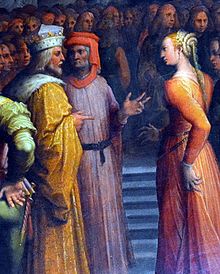Gualdrada Berti
Gualdrada Berti dei Ravignani(Florence,c. 1168 -Poppi,1226) was a member of theGhibellinenobility of twelfth-century Florence,Italy.A descendant of theRavignanifamily and daughter of the powerfulBellincione Berti,Gualdrada later married into theConti Guidofamily. Her character as a pure and virtuous Florentine woman is called upon by many late medieval Italian authors, includingDante Alighieri,Giovanni Boccaccio,andGiovanni Villani.[1]
Biography[edit]
Gualdrada was born around 1168 in Florence, Italy.[1]Her father, Bellincion Berti, was the powerfulGhibellinehead of the Ravingnani family.[1]Around 1180, Gualdrada became the second wife of CountGuido Guerra III"il Vecchio," an important general of theGuelphparty (the rival political party to her father's). This marriage was politically advantageous for Florence, as it stopped the ongoing hostile relationship between the Conti Guido family and the city.[1]Gualdrada continued to work as a mediator between the Conti Guido and Florence, with records showing her acting as a head of her family to free a monastery owned by the Guidi from an armed Florentine threat.[1]The four of her sons that lived into adulthood established the four branches in which the Conti Guido family split.[2]Gualdrada lived longer than her husband and died in 1226 in thePoppi Castle,a medieval castle in Poppi, Tuscany, which was owned by one of her sons.[1][2]

A Symbol of Virtue[edit]
Gualdrada's status as a famous Florentine woman and symbol of virtue was cemented by an episode first recounted inNuova Cronicaby mid-fourteenth-century Florentine historianGiovanni Villani.The historical reliability of this story, however, has been contested by scholars, as it is said to take place in 1209, a time where there is evidence of Gualdrada's sons already being adults.[1]Despite these inconsistencies, Gualdrada's legacy as a symbol of virtue is heavily entwined with this story reported by Villani.
In this role, Gualdrada is one of four women of her time to be written about inGiovanni Boccaccio'sDe mulieribus claris(On Famous Women),a collection of biographies of notable women ranging from theBibleandclassical antiquityto Boccaccio's contemporaries. In his biography of Gualdrada, Boccaccio calls upon Villani's episode: during a festival in a Florentine cathedral, theHoly Roman Emperor Otto IVspotted Gualdrada from his seat and was impressed with her beauty. He admired her youthful innocence, the way she dressed, and her personality. He asked who she was to the man beside him, describing her as having a "beautiful face that... surpasses all the others in dignity."[3]The emperor did not know that the man he was asking coincidentally was Gualdrada's father, Bellincione Berti. He responded to the emperor stating that if he wished, he could get Gualdrada to kiss him. Gualdrada overheard this exchange and bravely objected, stating that "no living man would ever kiss her except her husband," solidifying her character as one of womanly virtue and purity.[1]The emperor was both stunned and impressed by Gualdrada's response. Learning that he was speaking to her father, he praised her in an eloquent speech addressed to everyone present and celebrated her virtue. As he was leaving the festival, he summoned one of his barons, called Guido, and promoted him to a count. He then presented to Gualdrada a large dowry consisting ofCasentinoand a part of the territory ofRomagna.Gualdrada was then given to Guido in marriage.
Although this specific event most likely did not happen, Gualdrada was still married to Count Guido and was still a Florentine figure worthy of admiration for her mediation between the Conti Guido family and Florence.
In the sixteenth century, a room inPalazzo Vecchioof Florence was dedicated to Gualdrada as a personification of virtue.[1]The so-called Room of Gualdrada (Sala di Gualdrada) was located in the quarters ofEleanor of Toledo,wife ofCosimo I de' Medici,and it features a painted ceiling of the episode recounted by Villani and Boccaccio painted by the Flemish artistStradanus,also known as Giovanni Stradano, surrounded by detailed scenes of sixteenth-century Florence and allegories of virtue.[1]
In Dante'sDivine Comedy[edit]
Dantementions Gualdrada in hisDivine Comedy.Her name appears in Canto XVI, line 37 ofInferno,when Dante meets the Florentine man,Guido Guerra V,in the ring of the Seventh Circle ofHellreserved for the sodomites. Dante describes Guerra as the "grandson of the good Gualdrada,"[4]giving him the honor of coming from an admirable family and using Gualdrada's image of a virtuous and good woman to do so.
Dante himself was not only a Florentine, but a (White) Guelph, so the marriage between Gualdrada, a member of a notable Ghibelline clan, to Guido Guerra III, a Guelph leader, which ended hostilities between the two factions in the city of Florence, is an event that would be understandably important to him and worthy of praise and admiration.[5]This is especially likely since Dante started writingInfernosoon after he had been exiled from Florence for his political alignment as a White Guelph.[6]
Dante's respect for Gualdrada extends beyond her to her family as well. Her father, Bellincion Berti, is mentioned in Canto XV, lines 112-113 and Canto XVI, line 99 ofParadisoXV as a model citizen and a symbol of the virtue of old Florence.[7]
References[edit]
- ^abcdefghijBenson, Pamela (1999). "Gualdrada's Two Bodies: Female and Civic Virtue in Medieval Florence".The body and the soul in medieval literature: The J.A.W. Bennett Memorial Lectures, Tenth Series, Perugia, 1998, ed. Piero Boitani and Anna Torti.D.S. Brewer: 1–15.
- ^ab"Ravignani, Gualdrada dei in" Enciclopedia Dantesca "".www.treccani.it(in Italian). Retrieved 2021-03-30.
- ^Boccaccio, Giovanni (2003).Famous women.Translated by Brown, Virginia. Cambridge, Mass.: Harvard University Press. pp. 219–221.ISBN0-674-01130-9.OCLC50809003.
- ^Inferno.New York, NY: Anchor Books.DanteAlighieri, 1265-1321, RobertHollanderandJean Hollander,Inferno.New York, NY: Anchor Books, 2002.
- ^MANDELBAUM, ALLEN, et al., editors.Lectura Dantis: Inferno: A Canto-by-Canto Commentary.1st ed., University of California Press, 1998.JSTOR,www.jstor.org/stable/10.1525/j.ctt1pp55s. Accessed 30 Mar. 2021.
- ^"Dante Alighieri: A Chronology – Digital Dante".digitaldante.columbia.edu.Retrieved 2021-03-31.
- ^Dante, Alighieri, Robert Hollander, and Jean Hollander.Paradiso.New York: Doubleday, 2007. Print.
